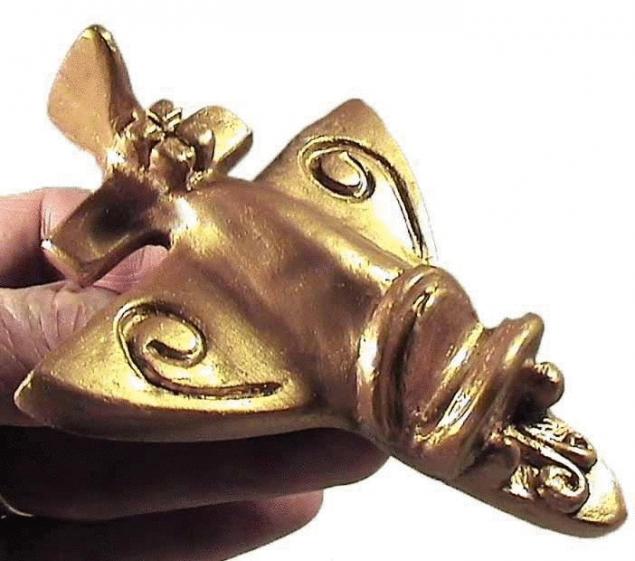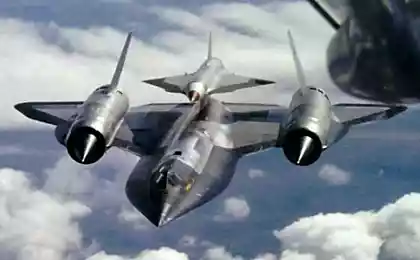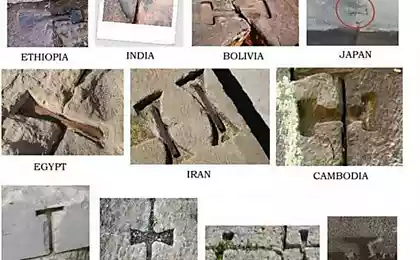576
Ancient aircraft— facts and criticism
December 12, 1903 in the town of kitty hawk (NC), the Wright brothers made the first ever controlled flight in a long self-propelled aircraft. Anyway, so today is estimated this event.
And whether familiar to man the feeling of flight before, hundreds or even thousands of years ago? Some researchers believe in the existence of data confirming this fact, but knowledge about it — alas! — was lost. Material evidence of flight in antiquity presents a mysterious artifacts in South America and Egypt as well as Egyptian rock paintings.
The first example of such facilities is the so-called Colombian gold airplane. It dates from 500 BC and belongs to the Tolima culture, which inhabited the hills of Colombia to 200-1000 ad Discovered drawings archaeologists traditionally think images of animals and insects, but some elements may be associated with the technology to create flying machines. To them in particular are: the deltoid wing and high vertical tail plane.
Another example is the pendant made of tombac (an alloy of gold and copper in the ratio of 30:70), a stylized flying fish. It belongs to the culture of Kalima, who occupied the territory in the South-West of Colombia (200 BC — 600 ad). The this pendant is in the book by Erich von Daniken "gold of the gods", published in 1972, the Author believed that the find is a picture of the aircraft that used the ethereal space aliens. Although the figure, according to archaeologists, was a stylized image of flying fish, some signs (in particular the outline of the tail) have no analogues in nature.
Several gold objects were made by the representatives of the culture of sin, who lived on the coast of Colombia in the 300-1550 and was known for his jewelry art. Items with a length of about 5 cm was worn on the neck as pendants on a chain. In 1954, products the Shin along with a collection of other valuable artifacts, the Colombian government sent to the exhibition in the United States.

After 15 years modern reproduction of one of the artifacts was provided for the study, the cryptozoologist Ivan T. Sanderson. He came to the conclusion that the subject has no analogues in the animal world. The front wings are in the shape of a triangle with smooth edges are different from the wings of animals and insects. Sanderson believed that they are more mechanical than biological origin, and even went further in his reasoning, suggesting that the object was a model of high-speed apparatus that existed at least 1000 years ago.
The appearance is similar to the plane of the artifact pushed Dr. Arthur Paisly to conduct an experiment in the aerospace tube Institute of Aeronautics in new York, and he received a positive result: the object really could fly. In August 1996, a copy of one of the Golden models that are built at a rate of 16:1, was launched into the sky by three German engineers Algonthm Enbom, Peter Bellingham and Conrad Libercom. From the results of the study, they concluded that the artifact is more like a modern Shuttle or the supersonic airliner "Concord" than an insect.
Most of these amazing South American pendants had four wings (or two wings and a tail). They were not like the now famous insects and birds. We can agree that this stylized model, however, their similarity with aircraft and spacecraft seems amazing. However, if we assume that objects are in fact patterns of some air vehicles that can fly, many questions arise.
The first problem is that mostly wings models are strongly shifted backward, that is, located far from the center of gravity, which prevents a stable flight. The second is that the nose is quite similar to the front of the aircraft.
Supporters of the theory of ancient aircraft conducted surprisingly little research, figuring out the answer to the question about the origin of the artifacts. On websites, in articles about the aircraft pre-Columbian America mainly as the objects found in the tombs of South or Central America, but in most cases does not provide information about their origin and Dating. Perhaps partly because of the still thriving in Colombia, the looting of ancient tombs, the contents of which then appears on the Antiques market in South America.
Most of the Internet sites devoted to the ancient South American aircraft, a compilation of articles Lu-the world of John. Iancu (1996), posted on the website of the "Anomalies and puzzles". In conclusion, I must say that, setting the origin of these amazing artifacts and culture to which they belonged, to regard them as models of ancient aircraft would be ill-advised.
Another model resembling a small plane was found in Sakkara in Egypt. Egyptologists think it is a hawk with outstretched wings and dated IV — III centuries BC, most likely found in 1898 in the tomb of PADI-Names in the Northern part of Saqqara. Pieces made of sycamore, is 14.2 cm in length with a wingspan of 18.3 cm and weighs approximately 39 g. the characters on the bird's tail reads: "an Offering to Amun", and the God Amon in Ancient Egypt was usually associated with rain.
The ancient model until 1969 had been stored in the Cairo Museum unless you drew the attention of the Professor of anatomy Messiha Khalil, who noted that she resembles a modern airplane or glider, in contrast to the images of other birds in the Museum, feet and feathers this object do not exist. According to Messiha, the exhibit has a number of aerodynamic characteristics. After his brother, a flight engineer by profession, has built a flying model from balsa wood, the confidence of Dr. Messiha that the bird of Saqqara is a scale model of an ancient airframe was strengthened.
However, this conclusion does not agree Martin Gregory from Harlow (Essex). More than thirty years he was engaged in designing, manufacturing and launching gliders. Experimenting with design, and Gregory came to the conclusion that the model can't fly without rudder (fixed horizontal tail plane of the coating), which the object never had. Even after Gregory was attached to the model of the Elevator, the results were not comforting.
The researcher suggested that it was a weather vane or a child's toy. Larry Orcutt, the user of the website, "Popular secrecy," based on the figures of birds on the top-masts of boats and ships, bas-relief images of the new Kingdom period (XII century BC), which can be seen in the temple of Khonsu at Karnak, called the object vane that showed the wind direction on the ship. Orcutt also noted on the back and tail paint. This may indicate that at the time the model birds were colorfully painted.
Black eyes, which actually are pieces of volcanic glass, recessed in the head of the model, not visible in most photos of the object, which gives it the appearance of an airplane. So, although the bird of Saqqara has a pair of aerodynamic properties, the version that it is the only surviving model of the Egyptian aircraft, it seems unlikely. Most likely (this is evidenced by the beautifully crafted Board games and toys) the artifact was a statuette of a bird, or baby toy.
Perhaps the most controversial evidence of flight in ancient times are mysterious rock carvings made on the panel of the temple of Pharaoh of the nineteenth dynasty SETI I at Abydos. On these amazing drawings, I think, the helicopter (probably the tank) and what looks like either a spaceship, or a jet. This so-called Abydos temple helicopter became a legend.
So, can these awesome characters considered evidence that the Egyptians in the thirteenth century BC had the technology of the XXI century? Unfortunately, some of the photos online are specially adjusted by using digital technology to highlight features, reminiscent of aircraft. However, there are other raw photos with the characters, similar to modern flying vehicle.
Katherine Griffis-Greenberg University of Alabama at Birmingham, like many archaeologists and Egyptologists, argues that the unusual rock paintings are a palimpsest with graffiti, made over the old one. According to Egyptologists, in this case over one of the images was coated with a layer of plaster and made other images.
From time to time and is influenced by weather conditions, the plaster began to fall away, leaving fragments of old and new labels, which are superimposed on each other, we created images that resemble modern aircraft. A significant part of the rock paintings of ancient Egypt: pharaohs came to power, was trying to usurp the achievements of their predecessors and to diminish their credibility. In the case of the helicopter shown in the bar of a temple in Abydos, apparently, the following happened: the Pharaoh Ramsee II, which was driven such a sin, carved on the stele of his predecessor, Pharaoh SETI I, private labels, appear in the text characters with part of a title of Ramses II, which is translated into a plus: "One of the two lords, conquering nine foreign countries." This inscription was blocked by the Royal title of Pharaoh SETI I that was originally carved in stone.
Those who believe in the helicopter of Abydos, argue that in rock palimpsests drawn on top of the images exactly repeat the old line is an incredible coincidence. However, there are other facts that denies the existence of flying machines in Ancient Egypt. One of them is the complete lack of mention of any flying machines all the known sources of Ancient Egypt. Somewhere there must be similar images, but they are not!
In addition (this applies to all theories on ancient artifacts), there is no evidence of the existence of auxiliary technical means needed to create flying machines. Assume that the cultures of Egypt and South America has created machines, prototypes of helicopters and airplanes. Then it should be a tremendous manufacturing industry, not to mention the extraction of fuels and metals. But what about equipment storage space for equipment?
Yes isn't it just? If the ancient people flying on modern aircraft and helicopters, of course, would be preserved much more evidence than a questionable collection of models, and a single panel with hieroglyphs carved in the temple above the doorway. We will not deny that the human dream of flying owes its origin to many ancient cultures, including Indian literature. Probably this idea is inspired by the inhabitants of South America on the creation of enigmatic models. Was there a dream implemented — this question remains controversial today.
Author: B. Haughton
"Great secrets and mysteries of history"
source: nlo-mir.ru
Source: /users/1080
Video games adversely affect children's memory
Philippine 15-year-old inventor generates energy when walking+video























